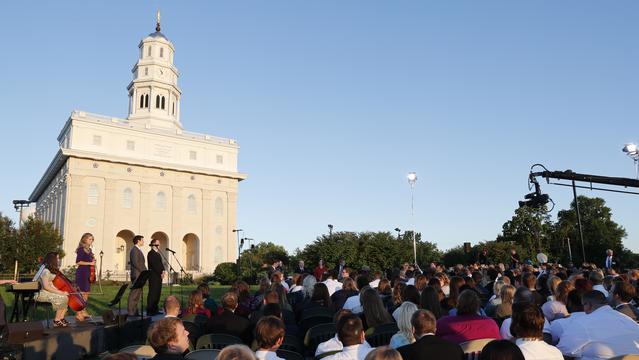Nauvoo Temple was the first in which ordinances such as eternal marriage and baptism for the dead were performed. This temple, which was such an integral part of the Lord’s work, was not completed before Joseph Smith died a martyr.
Construction of the Nauvoo Temple began in the spring of 1841 on a hilltop overlooking the Mississippi River. The Saints eagerly labored to receive the blessings promised by the Lord. In the baptismal font, dedicated nine months later, the Saints performed proxy baptisms in behalf of the dead.
Work on the temple continued at great sacrifice after the death of Joseph Smith, and portions of the temple were dedicated as they were completed. Between December 1845 and February 1846, nearly 6,000 Latter-day Saints received their endowments in this house of the Lord before moving west. The temple was dedicated in the spring of 1846.
After the Saints left Illinois, the temple was destroyed by fire and a tornado. The Church reacquired the temple lot in 1937 and rebuilt the Nauvoo Temple on its original site in 2002.
Quotes
Joseph Smith Quotes
Never since the foundation of this Church was laid, have we seen manifested a greater willingness to comply with the requisitions of Jehovah, a more ardent desire to do the will of God, more strenuous exertions used, or greater sacrifices made than there have been since the Lord said, “Let the Temple be built by the tithing of my people.” (Teachings of the Prophet Joseph Smith, sel. Joseph Fielding Smith (1976), 230.) See LDS Art Kit 73-674 Church Art Collection
Witnesses
John Taylor, 3rd President of the Church, 1880–1887
When the Temple was commanded to be built in Nauvoo, after the Temple had been built in Kirtland, and after so many keys had been turned, and after so many manifestations, visions and ministrations had been had, yet it was said then that there was not a place upon the earth in which to perform the ordinance of baptism for the dead, and Joseph was commanded to build a house for that purpose. (Deseret News: Semi-Weekly, June 10, 1884, 1.) See LDS Art Kit 73-889 Church Art Collection
In obedience to the Lord’s command, the Saints began “building a temple for the worship of our God in this place . . . one of the most lovely situations . . . in this region of country. It is expected to be considerably larger than the one in Kirtland, and on a more magnificent scale” (History of the Church, 4:229). See LDS Art Kit 73-113 Church Art Collection
At the time of its construction, the Nauvoo Temple was the biggest building east of St. Louis and west of Cincinnati, with an overall height of 158 1/2 feet.
From December 1845 to February 1846, Church leaders worked in the temple both night and day to administer its sacred ordinances to as many worthy Saints as possible before the Church was forced from Nauvoo. Nearly 6,000 faithful Saints received their endowments before moving west (Our Heritage: A Brief History of The Church of Jesus Christ of Latter-day Saints [1996], 60–61)
A defining characteristic of the Nauvoo Temple was the sunstone capitals that adorned the top of every pilaster. Of the 30 originally carved, only 3 remain, one of which is housed in the Smithsonian Institute in Washington, D.C.
After the Martyrdom of Joseph and Hyrum Smith, construction of the temple stopped briefly. Brigham Young, President of the Quorum of the Twelve Apostles, “inquired of the Lord whether we should stay here and finish the Temple. The answer was we should” (Office filer, Journal, 1837 July 27–1845 Apr. 1, entry for Jan. 24, 1845, Church Archives).
In Nauvoo, the Lord commanded that another temple be “built unto my name, that I may reveal mine ordinances therein unto my people; For I design to reveal unto my church things which have been kept hid from before the foundation of the world, things that pertain to the dispensation of the fulness of times” (D&C 124:40–41).
Brigham Young said that in 1844 “we did much hard labor on the Nauvoo temple, during which time it was difficult to get bread and other provisions for the workmen to eat.” However, faith and diligence were rewarded when a recent convert, Joseph Toronto, donated $2,500 to assist in the temple construction, enabling work to continue (B. H. Roberts, A Comprehensive History of the Church, 2:472). See LDS Art Kit 73-974 Church Art Collection
Joseph and Hyrum Smith rode on horseback from Nauvoo to Carthage of their own volition to answer false charges of riot. As they rode, “Joseph paused when they got to the Temple, and looked with admiration first on that, and then on the city, and remarked, This is the loveliest place and the best people under the heavens; little do they know the trials that await them’ ” (History of the Church, 6:554). See LDS Art Kit 73-554 Church Art Collection

